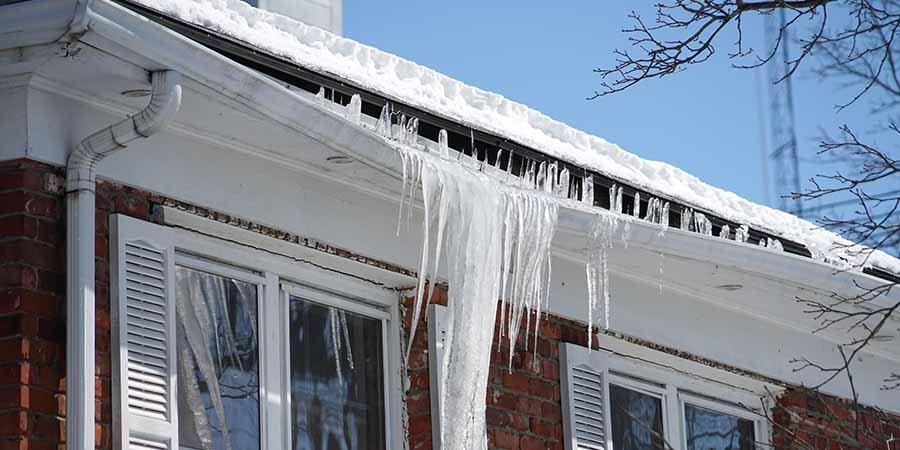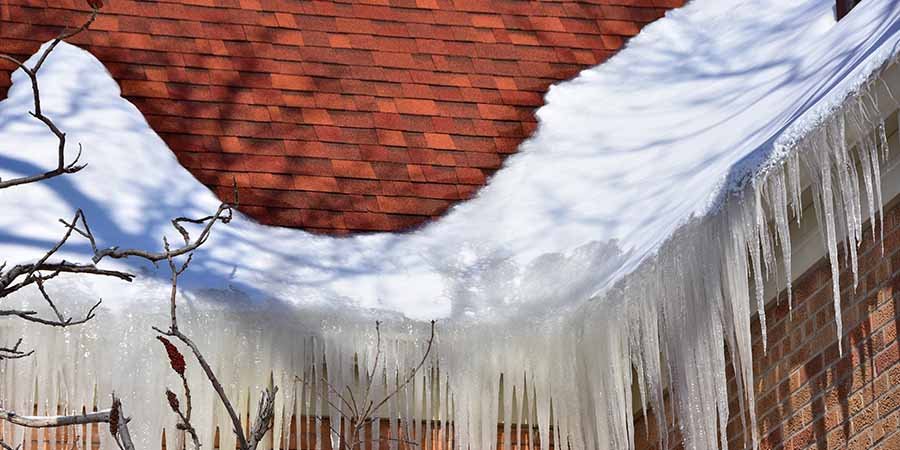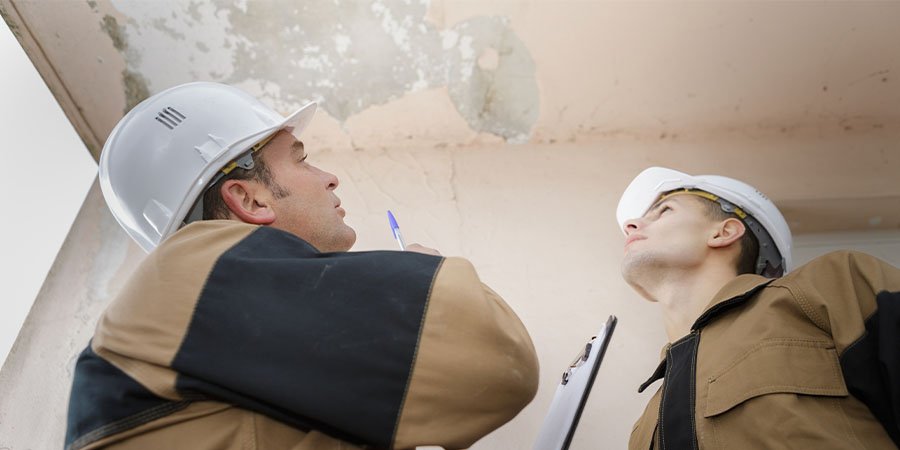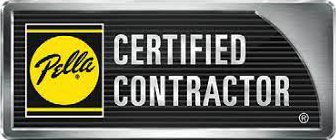
But when a disaster hits? Different problems arise.
In moments like that, you may be left wondering if your roof has storm damage?
One common problem — that can be very destructive — is the creation of ice dams.
These ice barriers present an additional variety of challenges that include damage to roofing, water leakage, and mold cultivation on walls.
Here’s what you need to know about ice dams this winter:
What is an ice dam?
 An Ice dam is a barrier of ice formed on the overhangs or at the edge of a roof that generally has a slope.
An Ice dam is a barrier of ice formed on the overhangs or at the edge of a roof that generally has a slope.
It occurs when rainwater and melted snow from the upper parts of the roof reach the cold eaves and drainpipes and refreeze there, forming a dam.
Ice dams commonly manifest themselves as a large mass of ice at the bottom ends of the roof with icicles hanging on the eaves.
When snow melts and flows off the roof toward the base of the ice dam, and the water can become trapped between layers of asphalt or other roofing materials.
Water can permeate through shingles, into the roof structure, and ultimately into the house! The result? Water leaks, ruined ceiling, walls, and insulation and possible mold development.
An ice dam also place pressure on the roof structure, causing problems with guttering, downspouts, and damage to the roof.
What causes ice dams?
What causes an ice dam? Here are some possible causes:
- Weather conditions: Ice dams are often created during times when temperatures are fluctuating. Snow in the upper portion of the roof melts, but the bottom of the roof remains under the freezing point. The snow melts on the roof and flows down toward the eaves or gutters, where it refreezes.
- Inadequate insulation: Lack of adequate attic or roof cavity insulation leads to warming up of interior air, which then rises and escapes along with the roof. That escaping heat warms up the roof, melting the snow covering it.
- Poor ventilation: Poor ventilation along with inefficient insulation aggravates the heat loss problem. Ice dam forms when hot and moist air gets trapped in the attic with no proper ventilation resulting in dampness.
- Heat loss from interior: Air leaking through loose joints, improperly sealed HVAC systems, inadequately sealed ductwork, and poorly installed insulation on recess lighting also contribute to ice dam formation.
What to do if you have an ice dam?
Prompt actions can limit the possible damage from an ice dam.
But safety is most important! Seek help from experts like Millard Roofing when necessary.
The cause of the ice dam should be addressed, and prevention techniques applied to stop the development of more ice dams.
What you can do
- Identify the affected areas: Check the roof for the areas where ice dams are built up. Evaluate signs of roof damage and water leakage.
- Remove snow from the roof: Use a roof rake or other tool to remove the snow from the roof. Be careful not to destroy the shingles and gutters while doing this!
- Create channels for water drainage: Forming melted channels through the ice dam using a calcium chloride ice melt product is recommended by some. Never use rock salt or sodium chloride as those damage roof materials and vegetation.
- Exercise caution when removing ice: Be cautious! Break the compacted ice using blunt-ended tools such as a rubber mallet or a wooden shovel. Avoid using sharp objects and hammers to reduce the chance of damage to the roof.
- Consult with professionals: If the ice dam persists or you are unsure, call a professional roofer for assistance.
- Address underlying causes: Don’t forget to tackle the root cause of the ice dam, if such problems are likely to reoccur in the future. A professional roofer can help identify and fix the cause.
If you need assistance from a professional roofer, contact Millard Roofing for a professional evaluation. We have the skills and expertise to effectively deal with ice dams and roof leaks.
How to prevent ice dams?
Home owners are advised to put together a set of actions aimed at even roof temperature distribution as well as minimal heat loss and snow deposition control.
- Upgrade insulation: The importance of upgrading insulation on the attic-roof space cannot be overemphasized. Insufficient insulation makes it difficult for heat to remain in living spaces and allows for the heat to rise and melt the snow on your roof.
- Proper air ventilation: Additionally, appropriate air ventilation is crucial for controlling temperatures and keeping humidity at appropriate levels inside the attic or roof cavity. Sealing air leaks within this space keeps warm air from being emitted out to the roof.
- Remove snow: Ice dams can also be prevented by regular clearing of snow from your roof, particularly around the eaves.
- Seek professional advice: A professional consultation with a roofer like Millard Roofing will offer suggestions on how to perform insulation improvements and update ventilation.
Taking these preventative steps can greatly minimize the opportunity for an ice dam to form on your roof.





